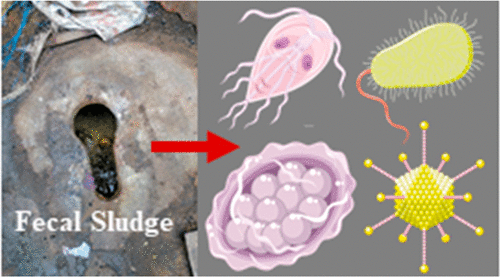当前位置:
X-MOL 学术
›
Environ. Sci. Technol. Lett.
›
论文详情
Our official English website, www.x-mol.net, welcomes your
feedback! (Note: you will need to create a separate account there.)
Analysis of Fecal Sludges Reveals Common Enteric Pathogens in Urban Maputo, Mozambique
Environmental Science & Technology Letters ( IF 8.9 ) Pub Date : 2020-10-13 , DOI: 10.1021/acs.estlett.0c00610 Drew Capone 1, 2 , David Berendes 3 , Oliver Cumming 4 , Jackie Knee 4 , Rassul Nalá 5 , Benjamin B Risk 6 , Christine Stauber 7 , Kevin Zhu 1 , Joe Brown 1, 2
Environmental Science & Technology Letters ( IF 8.9 ) Pub Date : 2020-10-13 , DOI: 10.1021/acs.estlett.0c00610 Drew Capone 1, 2 , David Berendes 3 , Oliver Cumming 4 , Jackie Knee 4 , Rassul Nalá 5 , Benjamin B Risk 6 , Christine Stauber 7 , Kevin Zhu 1 , Joe Brown 1, 2
Affiliation

|
Sewage surveillance is increasingly used in public health applications; metabolites, biomarkers, and pathogens are detectable in wastewater and can provide useful information about community health. Work on this topic has been limited to wastewaters in mainly high-income settings, however. In low-income countries, where the burden of enteric infection is high, nonsewered sanitation predominates. In order to assess the utility of fecal sludge surveillance as a tool to identify the most prevalent enteric pathogens circulating among at-risk children, we collected 95 matched child stool and fecal sludge samples from household clusters sharing latrines in urban Maputo, Mozambique. We analyzed samples for 20 common enteric pathogens via multiplex real-time quantitative PCR. Among the 95 stools matched to fecal sludges, we detected the six most prevalent bacterial pathogens (Enteroaggregative E. coli, Shigella/Enteroinvasive E. coli, Enterotoxigenic E. coli, Enteropathogenic E. coli, shiga-toxin producing E. coli, Salmonella), and all three protozoan pathogens (Giardia duodenalis, Cryptosporidium parvum, Entamoeba histolytica) in the same rank order in both matrices. We did not observe the same trend for viral pathogens or soil-transmitted helminths, however. Our results suggest that sampling fecal sludges from onsite sanitation offers potential for localized pathogen surveillance in low-income settings where enteric pathogen prevalence is high.
中文翻译:

粪便污泥分析揭示莫桑比克马普托市区常见肠道病原体
污水监测越来越多地用于公共卫生应用;废水中可以检测到代谢物、生物标志物和病原体,可以提供有关社区健康的有用信息。然而,该主题的工作仅限于主要是高收入环境中的废水。在肠道感染负担较高的低收入国家,无下水道卫生设施占主导地位。为了评估粪便污泥监测作为识别高危儿童中最流行的肠道病原体的工具的效用,我们从莫桑比克马普托市区共享厕所的家庭群中收集了 95 个匹配的儿童粪便和粪便污泥样本。我们通过多重实时定量 PCR 分析了 20 种常见肠道病原体的样本。在与粪便污泥匹配的 95 份粪便中,我们检测到了六种最常见的细菌病原体(肠聚集性大肠杆菌、志贺氏菌/肠侵袭性大肠杆菌、产肠毒素大肠杆菌、肠致病性大肠杆菌、产志贺毒素大肠杆菌、沙门氏菌) ,以及所有三种原生动物病原体(十二指肠贾第鞭毛虫、小隐孢子虫、溶组织内阿米巴)在两个矩阵中的排列顺序相同。然而,我们没有观察到病毒病原体或土源性蠕虫的相同趋势。我们的结果表明,从现场卫生设施中采集粪便污泥,可以在肠道病原体流行率较高的低收入环境中进行局部病原体监测。
更新日期:2020-12-08
中文翻译:

粪便污泥分析揭示莫桑比克马普托市区常见肠道病原体
污水监测越来越多地用于公共卫生应用;废水中可以检测到代谢物、生物标志物和病原体,可以提供有关社区健康的有用信息。然而,该主题的工作仅限于主要是高收入环境中的废水。在肠道感染负担较高的低收入国家,无下水道卫生设施占主导地位。为了评估粪便污泥监测作为识别高危儿童中最流行的肠道病原体的工具的效用,我们从莫桑比克马普托市区共享厕所的家庭群中收集了 95 个匹配的儿童粪便和粪便污泥样本。我们通过多重实时定量 PCR 分析了 20 种常见肠道病原体的样本。在与粪便污泥匹配的 95 份粪便中,我们检测到了六种最常见的细菌病原体(肠聚集性大肠杆菌、志贺氏菌/肠侵袭性大肠杆菌、产肠毒素大肠杆菌、肠致病性大肠杆菌、产志贺毒素大肠杆菌、沙门氏菌) ,以及所有三种原生动物病原体(十二指肠贾第鞭毛虫、小隐孢子虫、溶组织内阿米巴)在两个矩阵中的排列顺序相同。然而,我们没有观察到病毒病原体或土源性蠕虫的相同趋势。我们的结果表明,从现场卫生设施中采集粪便污泥,可以在肠道病原体流行率较高的低收入环境中进行局部病原体监测。











































 京公网安备 11010802027423号
京公网安备 11010802027423号